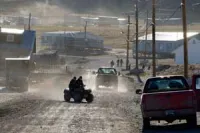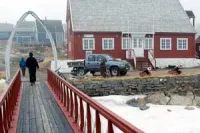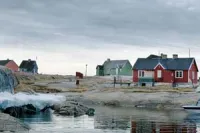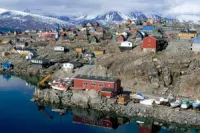Baffin Bay Region Narwhal Research
Baffin Bay Communities
The regions surrounding Baffin Bay in Canada and Greenland are composed of many Inuit communities. Hunters and elders in these communities have a long history of traditional knowledge regarding Arctic wildlife. Because many residents rely in part on narwhals for food, and hunters have developed extensive knowledge about narwhal behavior.
Research communities in the Canadian Territory of Nunavut
Arctic Bay (Ipiarjuk)
Population: 690
Geography: This high arctic community is surrounded by high hills creating a land-locked bay which gives rise to its Inuktitut name, Ipiarjuk, meaning “pocket” or “bag.” Much of the community is located near a gravel beach. Sea ice formation typically begins in October and thaw occurs in mid-July. Precipitation in this area is 0.7 meters (2.3 feet) of snow with an annual rainfall of 5 centimeters (2 inches).
Hunting: Traditional hunting of caribou, seals, and narwhal are all prevalent, though caribou sightings have become less frequent. Fishing is also common. Residents report frequent sightings of polar bears.
Broughton Island (Qikiqtarjuaq)
Population: 473
Geography: Qikiqtarjuaq is named for the community and the island in the Qikiqtaaluk Region of Nunavut. This northern access for Auyuittuq National Park is part of the Baffin Mountains which form part of the Arctic Cordillera mountain range.
Hunting: Traditional hunting and fishing are prevalent. There is diverse marine mammal wildlife including narwhal, killer whales, beluga, white whales, walruses, harp seals, and ringed seals.
Pangnirtung
Population: 1,325
Geography: This coastal plain community is part of the Pangnirtung Fjord, which eventually merges with Cumberland Sound.
Hunting: Subsistence hunting of seals, fish, caribou, whales and walruses is common. Cumberland Sound has a long history of commercial whaling.
Pond Inlet (Mittimatalik)
Population: 1,315
Geography: Mittimatalik is a high Arctic community on the northeastern tip of Baffin Island facing the mountains of Bylot Island. Because of its location on the north side of surrounding mountains, Pond Inlet has also been called Tununiq, meaning “the place that faces away from the sun.” For approximately three months in the summer, the sun never sets and in the winter there are three months when the sun never rises.
Hunting: A diverse assortment of wildlife inhabits the areas around Pond Inlet. Terrestrial animals include arctic terns, snowy owls, murres, snow geese, ptarmigan, jaegers, falcons, weasels, caribou, arctic foxes, hares, and wolves. Marine mammals include polar bear, narwhal, ringed seals, and walruses. Fish, such as Arctic cod and char are also prevalent.
Traditional knowledge about the Narwhal: Hunter David Angnatisiak notes that the size and length of a tusk is related to the skin patterns of narwhal of the same age. For example, the dark-skinned whales have very thick or wide tusks, while the tusks of more white colored whales are thinner in size. When asked about male narwhals using their tusks in any aggressive manner, David states that he has never seen narwhals fight using their tusks. However, he did hear one story of a boat being punctured from the bottom from a narwhal tusk. When asked about how tusk size relates to body size, elder Paniloo Sangoya said “They don’t relate to the size of the whale. They could be small and have a large tusk or vice versa.”
Repulse Bay
Population: 748
Geography: Repulse Bay is located on the Arctic Circle and on the south shore of Rae Isthmus.
Hunting: Traditional hunting and fishing is prevalent and includes narwhals, walrus, seals, caribou, and polar bears. There are over one hundred different species of birds, including peregrine falcons and gyrfalcons.
Traditional knowledge about the narwhal: Hunter Mark Tagoranak states, “One day, I saw one narwhal making loud noises at other narwhals who were in a lead inside the flow edge. A few minutes later, those narwhals left that lead and went to more open water. At this time, the ice was cracking and moving in such a way that the ice lead closed. I could see that this whale making the loud noises was telling the other whales to leave before the ice lead closed, saving their lives.”
Narwhal research communities in Greenland
Disko Island (Qeqertarsuaq)
Population: 925
Geography: Disko Island is located in the Davis Strait off the western coast of Greenland. Its Inuktitut name, Qeqertarsuaq, means “the large island” as it has an area of 8,578 square kilometers (3,312 square miles).
Hunting: Most of the meat and fish consumed by the inhabitants are from the local surroundings. Only 14 percent of the community are occupational hunters, and 35 percent are casual hunters. A wide spectrum of terrestrial and marine life is on or near the island. Residents also have a long history hunting whales, including fin, minke, and narwhal.
Traditional knowledge of the narwhal: Hunter Richard Broberg said, “The narwhal skin is very sensitive. You can’t even use an ice mattock (tooq: a tool to get a feeling how the ice is), and you can’t make a noise when there are narwhals. Even if the narwhals are far away, they will fly when an ignorant person uses an ice mattock. When we were hunting narwhals from ice close to land, early in the morning, and with an elder among us, we catch narwhals several times. When the ice is wet and humid, they are easily alerted under the ice. The hunters must take steps in the same time. The first one takes step and with him the others, not in different times. When they are not under the ice, we move faster, because they are not alert like when they are under ice. But when they dive, their hearing is much better, a noise, or if a dog sledge start on ice on the beach, they will warn each other and then they will swim away in big hurry, so you see only fog after them.”
Hunde Ejland
Population: 109
Geography: This small and relatively flat group of islands is located in the southern portion of Disko Bay.
Hunting: The waters surrounding this small group of islands are rich with a wide assortment of sea birds and whales.
Qaanaaq
Population: 645
Geography: Qaanaaq is the northernmost town in the Avanaa district of north Greenland. It is located on the Mares Strait, which separates Ellesmere Island in Canada from north Greenland.
Hunting: Most of the residents hunt a wide array of marine mammals and terrestrial wildlife. Hunting trips that last several weeks are common, and traditional methods allow hunters to utilize most of what is hunted.
Traditional knowledge of the narwhal: Hunter Kissuk said “Though many scientists describe the migration of narwhal to specific locations around Qaanaaq, we Inuit understand that the whales are nomadic like us; they go where the food is.”
Saqqaq
Population: 200
Geography: Saqqaq is located northwest of Ilulissat on the southwestern shore of Nuussauq Peninsula.
Hunting: Residents hunt terrestrial animals such as hares, ducks, geese, and caribou. Residents also fish and hunt marine mammals such as beluga whales and seals.
Uummannaq
Population: 1,296
Geography: Located 590 kilometers (367 miles) north of the Arctic Circle, the municipality of Qaasuitsup is located on Uummannaq Island in the Fjord separating mainland Greenland from Nuussuaq Peninsula.
Hunting: Hunters and fishermen set off on their dog sleds, hack holes in the ice, and drop long lines holding 200 to 400 hooks. The fish are pulled up manually some hours later. Modern times have brought some changes: hunters now use motorized vehicles, such as cars and snowmobiles. They also hunt for seals and whales.
Traditional knowledge about the narwhal: At the International Polar Year Conference in 2006, hunter Pavia Nielsen said, “When the whale arrives at our position, it is already getting dark for the winter. So, practically, we only have two hours of light to hunt. That way the nature already sets limits for our hunting. Therefore we can not hunt every single day. The force of nature which always given us a hard time in form of stronger and stronger wind, is getting even harder, because of global warming. When the wind is so strong, it means less hunting.”





